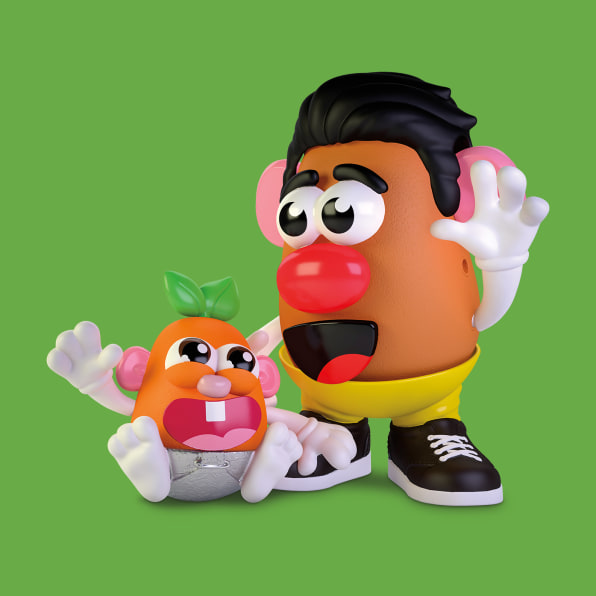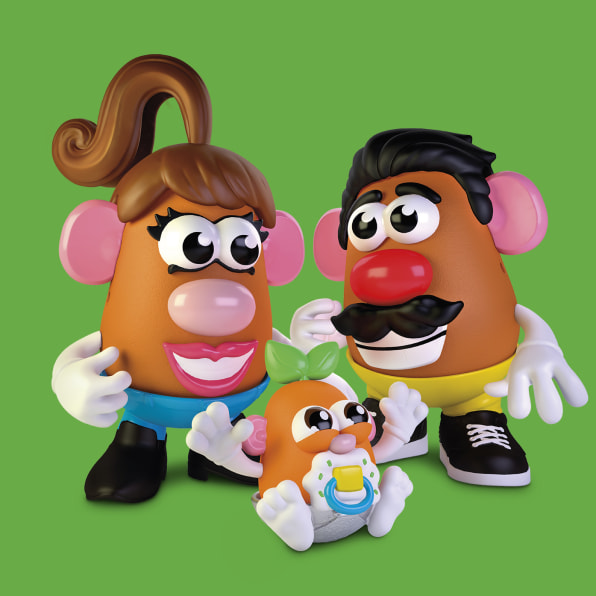The iconic Mr. Potato Head gets a 21st-century rebrand
Mr. Potato Head can now marry another Mr. Potato Head.
![]()
[Photo: Hasbro]

MORE LIKE THIS
Vivianne Castillo leaves Salesforce citing ‘rampant microaggressions and gaslighting’
The clever way strapped transit agencies are saving cash
Why the new USPS mail truck should be even dorkier
BY ELIZABETH SEGRAN3 MINUTE READ
This fall, you’re cordially invited to Mr. Potato Head’s wedding. He’s marrying his partner of many years, another Mr. Potato Head. And I promise it’s going to be the party of the year, with—you guessed it—plenty of spuds on the menu.
The toy giant Hasbro is rebranding its iconic Mr. Potato Head toy by dropping the “Mr.” from the name. On the surface, it may seem like a subtle shift, but it is designed to break away from traditional gender norms, particularly when it comes to creating Potato Head families—how toddlers frequently play with the toy, according to Hasbro’s research. But starting this fall, when the new brand is unveiled, kids will have a blank slate to create same-sex families or single-parent families. It’s a prime example of the way heritage toy brands are evolving to stay relevant in the 21st century.
[Image: Hasbro]Hasbro launched Mr. Potato Head in 1952 for the princely sum of $0.98 (or $10 in today’s currency). Back then, families had to supply their own real potato, which kids could then turn into little people thanks to plastic pieces in the box, such as hands, feet, and eyes, and accessories such as a pipe, and felt pieces that were meant to be mustaches. The following year, Mrs. Potato Head launched with feminized accessories, such as hair bows and red high heels. The Potato Heads were the first toys to be marketed directly to kids, and boy did that strategy work like gangbusters: More than one million kits were sold in the first year.
The enduring success of Potato Head comes down to its sheer silliness, says Kimberly Boyd, an SVP and GM at Hasbro who works on the Potato Head brand. The idea of a potato person with an enormous mustache is universally hilarious, particularly to the sensibilities of small children. But after that initial laugh, Boyd says that kids continue to engage with the toy because it provides a canvas onto which they can project their own experiences. “The sweet spot for the toy is two to three years old,” she says. “Kids like dressing up the toy, then playing out scenarios from their life. This often takes the form of creating little potato families, because they’re learning what it means to be in a family.”
 [Photo: Hasbro]Over the decades, the Potato Head brand has explicitly played into this tendency to create families. It has sold Mr. Potato Head family sets, with a male and a female character, along with smaller potato children. In 2012, Hasbro celebrated the 60th wedding anniversary of Mr. and Mrs. Potato Head with a boxed set featuring the couple. But eight years later, the brand wants to stop leaning so heavily into this traditional family structure. “Culture has evolved,” she says. “Kids want to be able to represent their own experiences. The way the brand currently exists—with the “Mr.” and “Mrs.”—is limiting when it comes to both gender identity and family structure.”
[Photo: Hasbro]Over the decades, the Potato Head brand has explicitly played into this tendency to create families. It has sold Mr. Potato Head family sets, with a male and a female character, along with smaller potato children. In 2012, Hasbro celebrated the 60th wedding anniversary of Mr. and Mrs. Potato Head with a boxed set featuring the couple. But eight years later, the brand wants to stop leaning so heavily into this traditional family structure. “Culture has evolved,” she says. “Kids want to be able to represent their own experiences. The way the brand currently exists—with the “Mr.” and “Mrs.”—is limiting when it comes to both gender identity and family structure.”

Mr. Potato Head can now marry another Mr. Potato Head.
[Photo: Hasbro]

MORE LIKE THIS
Vivianne Castillo leaves Salesforce citing ‘rampant microaggressions and gaslighting’
The clever way strapped transit agencies are saving cash
Why the new USPS mail truck should be even dorkier
BY ELIZABETH SEGRAN3 MINUTE READ
This fall, you’re cordially invited to Mr. Potato Head’s wedding. He’s marrying his partner of many years, another Mr. Potato Head. And I promise it’s going to be the party of the year, with—you guessed it—plenty of spuds on the menu.
The toy giant Hasbro is rebranding its iconic Mr. Potato Head toy by dropping the “Mr.” from the name. On the surface, it may seem like a subtle shift, but it is designed to break away from traditional gender norms, particularly when it comes to creating Potato Head families—how toddlers frequently play with the toy, according to Hasbro’s research. But starting this fall, when the new brand is unveiled, kids will have a blank slate to create same-sex families or single-parent families. It’s a prime example of the way heritage toy brands are evolving to stay relevant in the 21st century.
[Image: Hasbro]Hasbro launched Mr. Potato Head in 1952 for the princely sum of $0.98 (or $10 in today’s currency). Back then, families had to supply their own real potato, which kids could then turn into little people thanks to plastic pieces in the box, such as hands, feet, and eyes, and accessories such as a pipe, and felt pieces that were meant to be mustaches. The following year, Mrs. Potato Head launched with feminized accessories, such as hair bows and red high heels. The Potato Heads were the first toys to be marketed directly to kids, and boy did that strategy work like gangbusters: More than one million kits were sold in the first year.
The enduring success of Potato Head comes down to its sheer silliness, says Kimberly Boyd, an SVP and GM at Hasbro who works on the Potato Head brand. The idea of a potato person with an enormous mustache is universally hilarious, particularly to the sensibilities of small children. But after that initial laugh, Boyd says that kids continue to engage with the toy because it provides a canvas onto which they can project their own experiences. “The sweet spot for the toy is two to three years old,” she says. “Kids like dressing up the toy, then playing out scenarios from their life. This often takes the form of creating little potato families, because they’re learning what it means to be in a family.”
[Photo: Hasbro]The brand’s solution is to drop the gendered honorific title altogether. This means the toys don’t impose a fixed notion of gender identity or expression, freeing kids to do whatever feels most natural to them: A girl potato might want to wear pants and a boy potato might wear earrings. Hasbro will also sell boxed sets that don’t present a normative family structure. This approach is clever because it allows kids to project their own ideas about gender, sexuality, and family onto the toy, without necessarily offending parents that have more conservative notions about family.
 [Photo: Hasbro]This kind of freedom is not that common in children’s toys. In recent years, some heritage brands have evolved to keep up with the values of many of today’s parents; Mattel has worked to make Barbie dolls more ethnically diverse and size-inclusive, for instance. But few have pushed the boundaries on gender or sexuality. The storylines around Barbie and American Girl involve heterosexual marriage. And the many Disney princesses that fill our lives marry princes or stay clear of marriage altogether.
[Photo: Hasbro]This kind of freedom is not that common in children’s toys. In recent years, some heritage brands have evolved to keep up with the values of many of today’s parents; Mattel has worked to make Barbie dolls more ethnically diverse and size-inclusive, for instance. But few have pushed the boundaries on gender or sexuality. The storylines around Barbie and American Girl involve heterosexual marriage. And the many Disney princesses that fill our lives marry princes or stay clear of marriage altogether.
This can be confusing to kids who live in progressive milieus, where they are exposed to many different family structures. At my daughter’s school, for instance, kids appear to be constantly trying to make sense of how the heteronormative narratives around them square with their everyday reality, where some families have two moms or two dads, and others have a single parent. When my daughter plays dress-up in class, she sometimes marries a boy and sometimes marries a girl; it feels strange that not all toys give her this freedom.
But soon, she’ll be able to plan the Potato Head wedding of her dreams. And she’ll get to decide exactly what that couple looks like.
This can be confusing to kids who live in progressive milieus, where they are exposed to many different family structures. At my daughter’s school, for instance, kids appear to be constantly trying to make sense of how the heteronormative narratives around them square with their everyday reality, where some families have two moms or two dads, and others have a single parent. When my daughter plays dress-up in class, she sometimes marries a boy and sometimes marries a girl; it feels strange that not all toys give her this freedom.
But soon, she’ll be able to plan the Potato Head wedding of her dreams. And she’ll get to decide exactly what that couple looks like.
Comments
Post a Comment